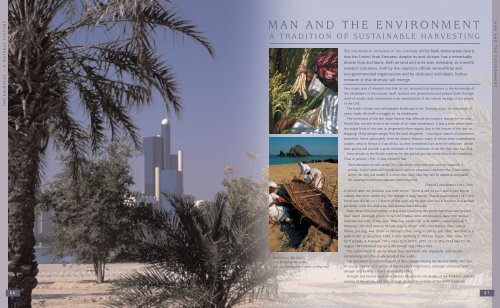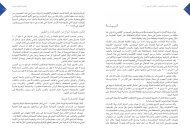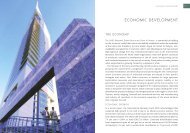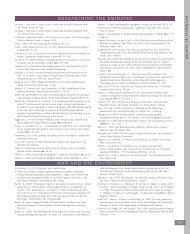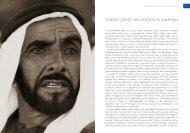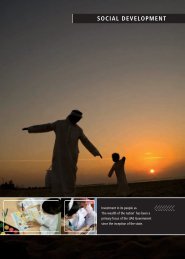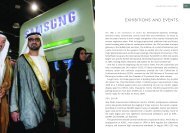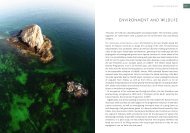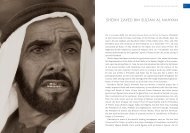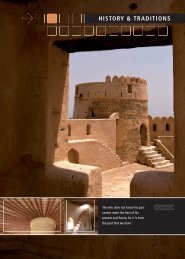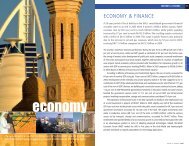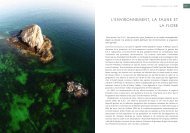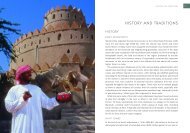MAN AND THE ENVIRONMENT - UAE Interact
MAN AND THE ENVIRONMENT - UAE Interact
MAN AND THE ENVIRONMENT - UAE Interact
Create successful ePaper yourself
Turn your PDF publications into a flip-book with our unique Google optimized e-Paper software.
T H E E M I R A T E S – A N A T U R A L H I S T O R Y<br />
<strong>MAN</strong> <strong>AND</strong> <strong>THE</strong> <strong>ENVIRONMENT</strong><br />
A TRADITION OF SUSTAINABLE HARVESTING<br />
<strong>THE</strong> INFORMATION CONTAINED IN <strong>THE</strong> CHAPTERS of this book demonstrate clearly<br />
that the United Arab Emirates, despite its arid climate, has a remarkably<br />
diverse flora and fauna, both on land and in its seas. Inevitably, as scientific<br />
research continues, both by the country’s official, semi-official and<br />
non-governmental organisations and by dedicated individuals, further<br />
measure of that diversity will emerge.<br />
One major area of research that has, as yet, received little attention, is the knowledge of<br />
the inhabitants of the country itself, learned over generations and passed down through<br />
word of mouth. Such information is an essential part of the cultural heritage of the people<br />
of the <strong>UAE</strong>.<br />
The harsh climate and inhospitable landscape of the Emirates have, for thousands of<br />
years, made life itself a struggle for its inhabitants.<br />
The memories of the last major famine that affected the country, during the Second<br />
World War, are still vivid in the minds of its older inhabitants. It was a time when even<br />
the staple food of rice was in desperately short supply, due to the impact of the war on<br />
shipping. Many people simply fled the land altogether – moving in search of sustenance<br />
elsewhere. Some, particularly from the Mazrui (Mazari), many of whom were coastal-based<br />
traders, went to Kenya in East Africa, as their forefathers had done for centuries, where<br />
their graves still provide a grim reminder of the harshness of the life that they had fled.<br />
Terse details in the British archives for the period provide some idea of the hardships.<br />
Thus in January 1941, it was reported that:<br />
M A N A N D T H E E N V I R O N M E N T<br />
There has been no rain except for a few drops, since last year, and the situation is<br />
serious. In fact cattle and camels are in such an emaciated condition that if rain occurs<br />
within the next few weeks, it is more than likely that they will be unable to withstand<br />
the consequent cold and exposure and will perish.<br />
(Trucial Coast Report 1941: 309)<br />
BACKGROUND: Abu Dhabi<br />
TOP: Fertilising date palms<br />
BOTTOM: Constructing a shasha fishing boat<br />
A month later, the situation was even worse: ‘There is still no rain, and it now seems<br />
unlikely that there will be any. The drought is really severe.’ (Trucial Coast Report 1941: 341).<br />
Some rain did fall on 13 March of that year, but by that time much livestock had already<br />
perished, while the date crop had already been affected.<br />
Even those who had money to buy food found that the prices had risen way beyond<br />
their reach. Although prices in the <strong>UAE</strong> market were not recorded, data from Muscat<br />
indicates the scale of the rises. Thus rice, which cost 11/4/- Indian rupees per bag in<br />
February 1941 had risen to 31/- per bag by March 1943, and imports then ceased.<br />
Wheat, per bag, was 10/10/- in February 1941, rising to 26/- by July 1942, and then to a<br />
peak of 45/- in November 1943, before declining to 39/12 in August 1944. Ghee, 3/12/-<br />
for 9 pounds in February 1941, was 15/- in March 1943, 21/- in May 1944 and 31/- in<br />
August 1944 (Political Diaries of the Persian Gulf 1940–1945).<br />
The replacement of rice by wheat flour and barley was unpopular, with people<br />
complaining that they made bread of low quality.<br />
The disruption to normal imports of food supplies during the Second World War was,<br />
of course, short-lived in terms of the country’s long history, although combined with<br />
drought and famine it had a devastating effect.<br />
Drought and famine were ever-present dangers for the people of the Emirates until the<br />
coming of the oil era, and only through detailed knowledge of the scant resources<br />
26<br />
27
T H E E M I R A T E S – A N A T U R A L H I S T O R Y<br />
available has survival been possible. It is not surprising, therefore, that the traditions of<br />
the people are full of references to the ways in which they made use of the terrestrial<br />
and marine environments, and the resources of flora and fauna to be found within them.<br />
These traditions reflect the knowledge that the people amassed and used, passing it<br />
down from generation to generation. Man’s survival in this land was dependent on<br />
maintaining a sustainable balance in the use of the available resources, providing a<br />
lesson for current and future generations.<br />
Perhaps, too, the very harshness of the climate and environment have had an effect<br />
on the people of Arabia themselves – bringing, over generations, the emergence of an<br />
adaptability and a capability for endurance that have become part of their essential<br />
characteristics and forging their spirit. The adaptability is also shown by the variety of<br />
professions to which people had to turn, just to survive. A man might be a camel-herder<br />
part of the time, then a fisherman, then a pearl-diver and then, with the help of his<br />
womenfolk, a simple agriculturalist, cultivating date palm gardens. Only through such<br />
a combination of occupations could he and his family survive.<br />
Indeed, the degree of the poverty in which many lived, until as recently as the 1950s,<br />
was so stark that it is difficult to comprehend. Thus one traditional fisherman, the late<br />
Darwish Juma al-Rumaithi, described to one of the authors before his recent death a<br />
lifestyle in which families living on the coast and islands were able to go inland during<br />
the hotter summer months only if they were fortunate enough to have around ten Indian<br />
rupees (less than a dirham) in hard cash. Otherwise, they had to stay where they were.<br />
Over the last few thousand years, three animals have become domesticated in the<br />
peninsula – the camel, the Arabian horse and the saluki dog. All of these share the<br />
same characteristics of endurance and adaptability, while the latter two also have a lithe<br />
gracefulness and nobility about the way in which they move that can, perhaps,<br />
be detected in the people themselves. As man can change the environment in which<br />
he lives, so too can the environment change man.<br />
That process, and the process by which man has learned to utilise the natural resources<br />
present in the environment has, of course, taken thousands of years. The earliest evidence<br />
so far identified of human occupation of the Emirates dates back to the Late Stone Age,<br />
or Arabian Neolithic period, around<br />
7,500–5,500 years ago. Archaeological<br />
sites from this period have been identified<br />
throughout the country, on offshore islands,<br />
along the coastline, in the deserts and on the<br />
semi-arid plains of the Northern Emirates,<br />
although, thus far, little has been identified in<br />
the Hajar Mountains.<br />
At the time, the climate was markedly<br />
different to that of today. Although temperatures<br />
may have been comparable, there was more<br />
rainfall and the period has also been described<br />
as the Climatic Optimum (Glennie et al. 1994).<br />
As a result of greater rainfall, the land itself would<br />
have looked rather different with far more vegetation<br />
than there is today. Besides streams in the mountains,<br />
there were permanent or semi-permanent lakes in<br />
some areas that are now desert or near-desert.<br />
Evidence of one such lake has been found at Ain<br />
al-Faida, near Al Ain (Gebel et al. 1989), while another<br />
has recently been identified by joint survey teams of the Environment Agency – Abu<br />
Dhabi (EA–AD) (formerly ERWDA) and the Abu Dhabi Islands Archaeological Survey<br />
(ADIAS), near Umm az-Zamul, in south-eastern Abu Dhabi.<br />
More plentiful fresh water and vegetation meant that more wildlife could survive.<br />
It is probable that there were extensive herds of large ungulates such as gazelle Gazella sp.<br />
and Arabian oryx Oryx leucoryx and, consequently, greater numbers of predators such<br />
as the leopard Panthera pardus nimr and hyaena Hyaena hyaena that depended on them.<br />
The now-extinct Arabian ostrich Struthio camelus syriacus may also have been present in<br />
considerable numbers.<br />
The earliest human inhabitants of the <strong>UAE</strong> clearly hunted the larger fauna, as shown<br />
by excavations at some of the country’s Late Stone Age archaeological sites.<br />
On Abu Dhabi’s offshore island of Dalma, for example, archaeologists have identified<br />
the bones of gazelles in deposits that have been dated to more than 7,000 years ago<br />
(Beech 2000).<br />
There is evidence, too, of the hunting of the wild camel Camelus dromedarius during<br />
the Bronze Age (3500 BC to 1300 BC), from the archaeological site of Tell Abraq, on the<br />
borders of Sharjah and Umm al-Qaiwain (Potts 2001).<br />
The wild camel appears to have become extinct, in the Emirates at least, towards the<br />
end of the Bronze Age, with a gap of several hundred years before the domesticated<br />
breed appears. Camels have been a source of meat, milk, and much more for the people<br />
of the <strong>UAE</strong> over the last 3,000 years. Indeed, it has been suggested that as rainfall declined,<br />
it was only the domestication of the camel that made it possible for man to continue to<br />
live in the deep deserts of Arabia.<br />
Another important discovery from the Dalma site has been evidence<br />
of the fruits of the date palm Phoenix dactylifera – the earliest<br />
evidence yet identified of human consumption of dates in Arabia<br />
(Beech and Shepherd 2001).<br />
The date palm still exists in a genuinely wild state, although not in<br />
Arabia where all of the palms can be identified as being of domestic<br />
origin. It is possible, although as yet unproven, that the earliest<br />
domestication of the species occurred in the peninsula.<br />
The Dalma site, as well as others from the Late Stone Age, such as<br />
those on Abu Dhabi’s island of Marawah, Al Madar and Akab in<br />
Umm al-Qaiwain, Jebel Buhais in Sharjah, Jazirat al-Hamra in Ra’s<br />
al-Khaimah and Khatmat Milaha near Kalba, on the East Coast,<br />
also demonstrate clearly that these earliest inhabitants of the Emirates<br />
were making good use of the resources available to them from the sea.<br />
A study of fish bones from Dalma, for example, has shown that a<br />
large variety of fish were being caught. These included thresher<br />
sharks, requiem sharks, hammerhead sharks, sawfish, eagle-rays,<br />
sea catfish, needlefish, groupers, jacks/trevallies, snappers, grunts,<br />
emperors, sea bream, parrotfish, barracudas and tuna/mackerel.<br />
Smaller fish were probably caught in shallow coastal waters,<br />
by using nets and tidal traps. Larger fish, such as tuna and mackerel<br />
may have been caught in deeper waters, suggesting that the country’s<br />
earliest-known inhabitants had developed the skills to build boats<br />
capable of venturing far out into the Arabian Gulf (Beech 2003).<br />
Other important food resources included shellfish and crabs,<br />
providing a varied diet for the occupants of the island. Shells from<br />
nearly 150 species of mollusc have been identified on the <strong>UAE</strong>’s<br />
Abu Dhabi’s offshore island of Dalma provides<br />
the earliest evidence yet identified of human<br />
consumption of dates.<br />
M A N A N D T H E E N V I R O N M E N T<br />
It has been suggested that as rainfall declined, it<br />
was only the domestication of the camel that<br />
made it possible for man to continue to live in<br />
the deep deserts of Arabia.<br />
The camel, Arabian horse and the saluki share<br />
the same characteristics of endurance and<br />
adaptability.<br />
28<br />
29
T H E E M I R A T E S – A N A T U R A L H I S T O R Y<br />
The <strong>UAE</strong>’s pearling industry flourished for many<br />
centuries, with Gulf pearls being exported to the<br />
markets of Imperial Rome, and later, to the<br />
courts of mediaeval Europe.<br />
Turtles were among the marine life that early<br />
<strong>UAE</strong> inhabitants harvested.<br />
pre-Islamic archaeological sites (Potts 2001). Many of these, such<br />
as the large gastropods Hexaplex kuesterianus and Terebralia<br />
palustris, would have been used primarily for food. The former,<br />
indeed, continued to be harvested for food until very recent<br />
times, although Terebralia, once widespread around the coastline<br />
of the Northern Emirates, from Dubai to Kalba, on the Gulf of<br />
Oman, has now disappeared from all but two localities, one of<br />
them man-made, on the East Coast.<br />
Molluscs were not only used for food. Excavations at the Jebel<br />
Buhais Late Stone Age cemetery in Sharjah, for example, as well<br />
as on Dalma, show that smaller shells were often pierced and<br />
used to make necklaces and other jewellery (Kiesewetter 2003;<br />
Shepherd and Popescu 2003).<br />
Also used for ornaments were the pearls found in the pearl<br />
oyster Pinctada radiata margaritifera shells, species found in<br />
abundance offshore, not only in deeper waters but also on<br />
shallower banks close to shore, where they could be collected by<br />
wading at low tide. The <strong>UAE</strong>’s pearling industry appears to date<br />
back to the Late Stone Age, for pearl oyster shells have been<br />
recovered in excavations on Dalma while a single pearl was found<br />
in a burial from the same period on the coastline of Umm al-Qaiwain (Phillips 2002).<br />
Subsequently, of course, the harvesting of pearls became an important industry.<br />
References in Assyrian and Babylonian texts to the import of ‘fish-eyes’ from the Gulf,<br />
dating back to the second millennium BC, are interpreted by archaeologists as meaning<br />
pearls (Leemans 1960). The pearling industry flourished in later times, with Gulf pearls<br />
being exported to the markets of Imperial Rome and later, to the courts of mediaeval<br />
Europe, while archaeological and historical evidence suggests that there was another<br />
boom in the eighteenth and nineteenth centuries, before the industry finally faded away<br />
in the first half of the twentieth century with the advent of the cultured pearl.<br />
Associated with pearling, at least around the beginning of the twentieth century, was the<br />
exploitation of another mollusc, the winged oyster Pteria macroptera. The lustrous nacre<br />
(‘mother-of-pearl’) on the inside of the shell, as well as that on the inside of P. radiata,<br />
was much sought after in the European market, where it was used, for example, to make<br />
buttons, and several tons were exported from the Emirates each year around the<br />
beginning of the twentieth century (Lorimer 1908).<br />
The pearling industry in the <strong>UAE</strong> came to an end only in the early 1950s, well within<br />
the lifetime of the country’s older inhabitants. As a result, the oral traditions associated<br />
with the industry have been preserved. Music, including the rhythmic chants of the<br />
sailors as they hauled in the pearl-divers and their harvest, and poetry are among the<br />
most important of these aspects of the <strong>UAE</strong>’s culture and folklore.<br />
Other marine and coastal resources were exploited too. Besides fish and shellfish, the<br />
early inhabitants of the Emirates also learned to harvest other fauna, including the<br />
dugong (or ‘seacow’) Dugong dugon and turtles. Dugong and turtle bones have been<br />
found on Late Stone Age archaeological sites, and both continued to be harvested until<br />
relatively recent times.<br />
In the 1940s, Wilfred Thesiger recorded that:<br />
It is possible that the same use had been made of them for thousands of years. The meat was<br />
eaten both fresh and dried, in a fashion similar to the dried ‘biltong’ of South Africa.<br />
Another use of the dugong, not cited by Thesiger, was the fact that the oil produced from<br />
its fat was used to anoint both the insides and the outsides of boats, to prevent the wood<br />
from drying out, and also to keep it waterproof (Saif Mohammed al-Mazroui, pers. comm.<br />
2004). The tusks were carved to make sticks for the application of kohl as make-up for the<br />
eyes of the womenfolk.<br />
Birds and their eggs (as well as turtle eggs) were also collected. Species that were of<br />
particular importance were the Socotra cormorant Phalocrocorax nigrogularis and tern<br />
Sterna sp. The close-packed breeding colonies provided easy access to eggs, with these<br />
generally being collected early in the season before incubation had begun. As a result,<br />
the birds would lay again, rather than abandon the nest. In consequence, the fishermen<br />
who depended on the bird colonies for a useful food supplement were able to devise an<br />
ecologically-sustainable pattern of exploitation, never taking more eggs than the breeding<br />
population could stand.<br />
Besides the eggs, young cormorants were also harvested, while from time to time,<br />
other bird species were also exploited for food, including, occasionally, the greater flamingo<br />
Phoenicopterus ruber.<br />
The guano of the cormorants was once collected as well, and the great Arab historian<br />
al-Idrisi referred in the twelfth century AD to its export from the islands of the southern<br />
Gulf to Basra, where it was used as a fertiliser in palm groves and vineyards. Al-Idrisi wrote:<br />
These parts are full of chasms, sandbanks and places which are difficult of access.<br />
They are known as the sea of Kithr (Qatar); there are a great number of desert islands<br />
frequented only by water or land birds, which gather there and leave their droppings.<br />
When the weather permits, these droppings are loaded into small craft and transported<br />
to Basra and other places, where they are sold for a very high price, since they are<br />
considered to be a powerful fertiliser for vines, date palms and in general for gardens.<br />
(Bombaci et al. 1972)<br />
As late at the 1940s, concessions were still being awarded by the Ruler of Abu Dhabi for<br />
the collection of guano from islands such as Mahammaliyah and Ghagha’ in the Western<br />
Region of Abu Dhabi (Buraimi Memorials 1955).<br />
Recent archaeological studies have revealed a limited amount of information on the<br />
diets of former inhabitants of the region. The exploitation of animals is well-documented<br />
from bones, although plant remains are often not well preserved in the archaeological<br />
record. Thus Potts (2001) provides a list of 24 species of flora attested from archaeological<br />
Greater flamingo Phoenicopterus ruber<br />
A colony of Socotra cormorants Phalocrocorax<br />
nigrogularis<br />
M A N A N D T H E E N V I R O N M E N T<br />
Sea cows (dugong) known as Baqar al bahr are common in the straits of Al Bazam. The<br />
Arabs catch them in nets and there is a big demand for their meat and for their hides,<br />
which are used to make sandals.<br />
(Thesiger 1949)<br />
30<br />
31
T H E E M I R A T E S – A N A T U R A L H I S T O R Y<br />
The asphodel lily Asphodelus tenuifolius is one<br />
of many plants used in traditional herbal<br />
medicines,<br />
sites in the <strong>UAE</strong> but, of these, 8 are domesticates, including wheat, barley and the date<br />
palm. Of the wild species, however, most are trees, likely to have been exploited<br />
as firewood or for building, rather than as food. Only a wild oat, Avena sp., was clearly<br />
a food item – and then, perhaps, for domesticated animals.<br />
It is not always possible to tell from such studies how the people might have made<br />
use of particular animals, or of particular seasons of the year. For this, one must turn to<br />
the more recent traditions, whether recorded by mid-twentieth century visitors like the<br />
explorer Sir Wilfred Thesiger, or collected from the country’s older inhabitants.<br />
As one might expect, much use was also made of native plants. Thesiger reported,<br />
for example, that:<br />
. . . truffles (fagah in local Arabic) (Trefezia goffartii?) grew in the Taff this year in<br />
December and January and edible toadstools (Podaxon) were plentiful in the Khatam in<br />
April and May and in November and December. Tarthuth (Cynomorium coccineum)<br />
[red-thumb] and basul (Cistanche lutea) were common in the Khatam, the Ramlat al<br />
Hamra, the Batin and Liwa. Badu eat the tarthuth raw and their camels eat the basul.<br />
(Thesiger 1950)<br />
Tarthuth, known in English as ‘red thumb’, was reputed to have special properties, and<br />
has been described, in a North African context, by one author as:<br />
Entire plant aphrodisiac, spermatopoietic, tonic, astringent. Dried plant powdered and<br />
mixed with butter used for biliary obstruction. Powder added to meat dishes as a<br />
condiment.<br />
(Loutfy 1987)<br />
Another seasonal delicacy was Dipcadi erythraeum, a small member of the lily family, which<br />
grows in sandy areas close to the coast and can also be found close to desert outcrops<br />
such as Qarn Nazwa. Both its small bulb and its leaves were used for salads, as were the<br />
leaves of the adder’s tongue fern, Ophioglossum polyphylum.<br />
Plants were also used for traditional herbal medicines, based on folk knowledge<br />
collected over centuries and handed down, both through the general population and<br />
traditional healers. Thus the seeds of senna Cassia italica are a powerful laxative as were<br />
the fruits of the desert squash Citrullus colocynthis and the asphodel lily Asphodelus<br />
tenuifolius. Even poisonous plants could be used, like the oleander Nerium oleander,<br />
whose crushed leaves were applied to the skin to treat lesions and tumours. A useful<br />
summary of the medicinal and other uses<br />
of plants is contained in The Comprehensive<br />
Guide to the Wild Flowers of the United<br />
Arab Emirates (Jongbloed 2003),<br />
published by EA–AD (formerly ERWDA).<br />
Today, this medicinal knowledge is<br />
being collected and studied by the Zayed<br />
Complex for Herbal Research and<br />
Traditional Medicine, a part of the Ministry<br />
of Health. Located at Mafraq, just outside<br />
Abu Dhabi City, the Zayed Complex has<br />
departments specialising in ethnobotany,<br />
pharmacognosy, pharmacology and<br />
microbiology, and also offers training in<br />
alternative medicine.<br />
The Bedouin inhabitants of the desert<br />
made good use of areas which, after<br />
rainfall, provided good pastures for their<br />
flocks of camels, sheep and goats, and the Abu Dhabi Islands Archaeological Survey<br />
(ADIAS) has identified camp-sites which, from the variety of pottery present, must have<br />
been used as a centre for winter grazing for many hundreds of years. Some, indeed, are<br />
still in use today.<br />
After periods of intensive drought, or after an area had been heavily grazed, Bedu would<br />
collect seeds from other areas and then scatter them over the sands in a favoured pasturing<br />
area, in a simple but effective way of regenerating the natural vegetation.<br />
Of prime importance, of course, has been the date palm. Its fruits have played a key<br />
role in sustenance of the local people and their camels. Virtually every part of the tree<br />
was put to good use. The strong fronds of its leaves, for example, once dried, formed the<br />
basic material for the construction of the ’arish (palm-frond) structures that were used as<br />
shelters in the deserts, or as wind-breaks and for fencing along dune-faces to help hold<br />
back the drifting sand. Once dried and split, strips of palm leaves, known as khooss,<br />
were woven into matting for floors, or to make simple containers for a variety of items<br />
for use in the household or tent, such as conical covers for food and trays – still available<br />
at wayside markets. The matting itself could be conveniently rolled up and carried by<br />
camel from one desert camp to another. Round long rectangular bags (gullah), rather like<br />
cement bags (y’rab), were used as containers into which dates were packed tightly.<br />
The date syrup then oozed through the mesh and could be collected, with these bags<br />
acting as an easily transportable version of the date presses or madbasa to be found in<br />
farming settlements in the Northern Emirates and near Al Ain.<br />
The date trunks, once carefully split, could be laid end-to-end to serve as conduits for<br />
irrigation water, while the long and tough stalks of the leaves were used, at least on the<br />
<strong>UAE</strong>’s East Coast, to make shashas, small boats capable of carrying one or two fishermen.<br />
Their stalks absorbed water but the shasha itself was buoyant enough to ride on the sea.<br />
It was used regularly southwards down the Batinah coast of Oman as far as Sohar, and<br />
even, on occasions, as far as Muscat (Ziolkowski 2000).<br />
Dried date-palm fronds were used to construct<br />
houses, shelters and windbreaks in the desert.<br />
The strong leaf stalks of the date palm were<br />
used to make small fishing boats and fish traps.<br />
M A N A N D T H E E N V I R O N M E N T<br />
The crushed leaves of oleander Nerium<br />
oleander were applied to skin lesions and<br />
tumours.<br />
32<br />
33
T H E E M I R A T E S – A N A T U R A L H I S T O R Y<br />
Calligonum comosum was among the bushes<br />
used for firewood in desert areas.<br />
The black mangrove Avicennia marina was<br />
harvested for firewood and for the construction<br />
of simple structures.<br />
Another important tree was the black mangrove Avicennia<br />
marina, harvested both for firewood and for use in the making of<br />
simple structures. Today, this is the only species of mangrove to<br />
be found in the wild in the Emirates. Archaeological sites from the<br />
pre-Islamic period, however, have shown that another species,<br />
Rhizophora mucronata, was also present, for its remains have been<br />
found in excavated charcoal and ash. Was this species, perhaps,<br />
exploited until it became extinct, or was the wood imported<br />
from elsewhere?<br />
Also used for firewood, until today, have been trees like the<br />
Zizyphus spina-cristi and the Acacia tortilis. In desert areas,<br />
where there was less vegetation, bushes as well as trees were<br />
used for firewood, favourites being the arta or Calligonum<br />
comosum, C. crinitum and the saxaul Haloxylon persicum.<br />
While the people of the Emirates have always made use of the plants to be found in the<br />
deserts, gravel plains and mountains, they have also exploited the native wildlife for food.<br />
This practice, as shown above, dates back to the earliest recorded presence of man in the<br />
<strong>UAE</strong>, over 7,000 years ago, but continued to be of importance until the mid-twentieth<br />
century and the beginning of the era of oil-fuelled development.<br />
Hunting was an important way of supplementing the often-meagre diet available to<br />
the country’s population.<br />
In the mountains, the Arabian or mountain gazelle Gazella gazella and the Arabian tahr<br />
Hemitragus jayakari were much sought after and, in consequence, the main competitor for<br />
their meat, the Arabian leopard, was a target for the hunters.<br />
In the deserts, the choice of larger prey included the Arabian gazelle, the sand gazelle,<br />
Gazella subgutturosa marica, the Arabian oryx and the Arabian ostrich Struthio camelus<br />
syriacus. Pursuing such animals in the days before modern weaponry and when there<br />
were no four-wheel drive vehicles available with which to chase them, required extensive<br />
knowledge both of their habits and of the environment itself, skills which are now<br />
gradually fading away. It required endurance too – some local Bedu, or so they still<br />
claim, could once, when they were young, follow a gazelle on foot through the desert in<br />
the summer heat, keeping the animal continually on the move until it eventually<br />
collapsed from exhaustion and could be<br />
caught. There are, even today, hunters in<br />
Oman’s mountains who can pursue, on<br />
foot, the agile Arabian tahr until that, too,<br />
is exhausted. The enormous expenditure<br />
of energy by the hunter was then<br />
rewarded by sufficient food to make the<br />
chase worthwhile.<br />
Smaller animals too were caught for<br />
food. Thesiger reported, for example, that:<br />
‘Dhub’ (Uromastyx microlepis) and ‘damusa’<br />
(Scincus sp.) [sandfish – known as ‘hilicha’<br />
among the <strong>UAE</strong> desert tribes] are eaten by<br />
the Bedu and I found their meat most<br />
pleasant. ‘Rual’ or ‘waral’ (Varanus sp.)<br />
[the monitor lizard] are eaten by the Bani<br />
Kitab and other Omani tribes.<br />
. (Thesiger 1949)<br />
For these reptiles, all that was required was a keen eye to spot them and, for the dhub, a<br />
simple trap to entangle them as they emerged from, or ran to, their burrows. Their roasted<br />
tails were a particular delicacy, tasting something like chicken, and were reputed to have<br />
aphrodisiac qualities. The hilicha (the sandfish S. mitranus) is still occasionally eaten today<br />
by those who have a particular interest in retaining past ways and traditions.<br />
There was, though, quite an extensive degree of variety in what might be eaten. While<br />
Thesiger recorded the Bani Kitab as eating the desert monitor, it was not eaten by the Bani<br />
Yas, who valued it as an animal that caught and killed snakes, while the Awamir of the deep<br />
desert would never touch it, ascribing to it somewhat menacing and mystic properties.<br />
Just as habits differed from tribe to tribe, so names differed too – the desert monitor,<br />
most commonly known as waral, was the rual to some Omani tribes and the wurral or<br />
wurraili to some of the Bani Yas and the Awamir. The topic of the differing local names,<br />
though fascinating, is beyond the scope of this book. The very fact that they differ,<br />
however, is an indication of the familiarity of the people with the wildlife around them.<br />
Large rodents, such as the Arabian hare Lepus capensis, could also be caught by<br />
detecting them as they lay concealed in their forms or by an accurate shot. For these,<br />
though, as well as for two of the most-prized birds of the desert, the houbara Chlamydotis<br />
macqueenii, a large member of the bustard family, and the stone curlew or kairowan,<br />
Burhinus oedicnemus, other techniques were also brought into play – those of training<br />
other species of fauna to help.<br />
One was the saluki, a member of the dog family that resembles a greyhound. It has been<br />
a companion of man in the deserts for many hundreds, perhaps thousands of years. In the<br />
late 1940s, Sheikh Zayed, at that time Ruler’s Representative in Al Ain, kept a saluki dog<br />
for hunting Arabian hares. It was, Thesiger noted: ‘still too young to catch a full-grown<br />
hare, although he managed to catch an occasional leveret’ (Thesiger 1983).<br />
Unlike all other dogs, the saluki is not considered by Muslims to be unclean, and<br />
the breed can still be found today in some of the remoter desert encampments,<br />
while in recent years, the Arabian Saluki Centre has been established,<br />
with the help of the Environment Agency – Abu Dhabi (EA–AD)<br />
(formerly ERWDA), to encourage conservation of the breed.<br />
Perhaps the best-known use of trained wildlife for hunting, at<br />
least in Arabia, is the use of falcons to hunt houbara, stone curlews<br />
and hares. The use of falcons by the desert inhabitants of the <strong>UAE</strong><br />
probably dates back to the pre-Islamic period. Two species of falcon have<br />
traditionally been used, the saker Falco cherrug and the peregrine Falco peregrinus,<br />
although occasionally the Barbary falcon Falco pelegrinoides, a smaller bird that is<br />
a close relative of the peregine, is used to introduce children to falconry.<br />
Falconry has long been a sport of the leaders of a community – and that has been<br />
true in Arabia as much as elsewhere. For the ordinary nomadic Bedu, however, it has<br />
always been something more than a sport – it was an important way of supplementing<br />
the diet, and an essential part of the strategy for obtaining food.<br />
Today, the <strong>UAE</strong>’s falconers are increasingly using captive-bred birds, in particular hybrids<br />
between the saker and the gyr falcon Falco rusticolus, which are more powerful than the<br />
pure-bred sakers or peregrines. The process is being encouraged by the Emirates Falconers’<br />
Club, as a way of reducing pressure on the wild falcon populations. Strict rules have also<br />
been introduced to control the import of wild falcons caught elsewhere.<br />
Preparations for the hunting season began in September each year, as the falcons began<br />
to arrive in the Emirates on their autumn migration. Selecting elevated points along the<br />
coastline and islands or, ocasionally, deeper into the deserts of Abu Dhabi’s Western<br />
Region, falcon-trappers excavated small hides which they covered with bushes, in which<br />
A dbub lizard Uromastyx aegyptia microlepis<br />
M A N A N D T H E E N V I R O N M E N T<br />
34<br />
35
T H E E M I R A T E S – A N A T U R A L H I S T O R Y<br />
to conceal themselves. Then a pigeon would be tethered on a string and let loose nearby.<br />
Seeing the bird, and recognising that something was preventing it from flying away, the<br />
falcons would identify it as easy prey, coming in to catch it. Once the falcon was occupied<br />
eating the pigeon, the trapper would cautiously approach to entangle it in a net or a cloth.<br />
Alternatively, the trapper would use the string to draw the pigeon gradually towards him.<br />
The falcon, intent on its prey, would follow the pigeon until, once again, it was within<br />
reach of the trapper.<br />
In the desert, a different approach was used. If a falcon was seen in the early morning,<br />
a trapper would return early the next morning, along with a friend, on a single camel,<br />
and carrying a pigeon. Once the falcon had been seen in the distance, the two men<br />
would dismount and, concealing themselves behind the crouched camel,<br />
one of them would bury himself in the sand, with the pigeon once again attached<br />
to a string. The second man would then mount the camel and move off.<br />
Once the falcon saw the pigeon, apparently in difficulties and unable to fly away,<br />
it would come to take the prey, whereupon it was captured.<br />
A second method was to use a kestrel Falco tinnunculus, a small falcon that is a<br />
resident breeder in the Emirates. Larger falcons, such as sakers and peregrines,<br />
will attack the smaller kestrel, which would have fine snares and feathers<br />
attached to it. When a trapper saw a large falcon, he would then release<br />
the kestrel to fly. The saker or peregrine would then attack the kestrel,<br />
become entangled in the snares, and both would fall to the ground.<br />
Once trapped, a saker or peregrine underwent, and still undergoes,<br />
a period of training using lures, before it is ready to be used in hunting.<br />
On occasion, falcons were used in conjunction with salukis. Thesiger, noted:<br />
Hunting parties are followed by two or three saluki dogs, which course any hares that are<br />
put up, and I have never seen a hare escape when hunted by both a falcon and salukis.<br />
(Thesiger 1950)<br />
Salukis were also used occasionally in the hunting of houbara, as recorded by Thesiger:<br />
For the avid falconer today, the pursuit is something almost akin to an addiction, and<br />
when the hunting season approaches, there is a detectable excitement. Once out in the<br />
field, attuned to the bird and to nature, other concerns of importance, whether work or<br />
family, simply fade away.<br />
Describing the effect that the arrival of the falconry season has on its devotees, the<br />
popular contemporary Arab poet Abdullah bin Aun says:<br />
At this time, you forget that you’re loved<br />
By the love of your life.<br />
And your official tasks too,<br />
Be you of high or low post,<br />
Will vanish, like mist,<br />
Gone from your mind.<br />
Not only was the careful exploitation of the country’s fauna and flora an important aspect<br />
of the traditional lifestyle of the people of the Emirates, but aspects of the geology, too, were<br />
put to good use. In the Western Region of Abu Dhabi, for example, the diapiric salt-dome<br />
of Jebel Dhanna was a source of pure sulphur crystals that could be extracted by mining.<br />
During the seventeenth to the nineteenth century, the mountain was mined extensively to<br />
produce many tons of sulphur, probably for use in the making of gunpowder. The sulphur<br />
was also exploited on a lesser scale until at least the 1950s for the manufacture of kastan,<br />
a paste that was used for the treatment of sores on camels (King 2003).<br />
When one looks back today at the ingenuity of the people of the Emirates in adapting<br />
to the harsh conditions in which they lived, traces of their skills can be detected in almost<br />
every sphere of life. There were even ways of dealing with the lack of rainfall, and the<br />
consequent shortage of fresh water. The underground water-channels (aflaj) that permit<br />
agriculture in the mountain wadis and in the<br />
oases close to the mountains, such as Al Ain and<br />
Dhaid, first appeared around 1000 BC, and many<br />
still remain in use (Al-Tikriti 2002). On the coast<br />
and islands, simple water-collection systems<br />
ensured that rainfall was not wasted while, when<br />
necessary, fresh water was brought by boat to the<br />
coastal settlements. Thus Dalma and Sharjah<br />
supplied water to Abu Dhabi in the 1940s and,<br />
on occasions, water was even brought by dhow<br />
from as far away as Kuwait.<br />
Since the first-recorded presence of man in the<br />
Emirates, good use has been made of the<br />
country’s natural resources. Indeed, had that not<br />
happened, then it would have been impossible in<br />
the pre-oil era for people to have lived here at all.<br />
As a result, extensive knowledge of the resources<br />
and when and where to find them developed,<br />
along with a recognition of the need for any<br />
exploitation to be sustainable. Feeding through<br />
into the culture and traditions of the people, this<br />
knowledge has been an essential part of life in<br />
the Emirates, and its recording and preservation<br />
remains a key priority today.<br />
M A N A N D T H E E N V I R O N M E N T<br />
The Arabs encourage their salukis to follow a falcon as soon as it is loosed. The dogs<br />
then either force the bustard back into the air, or help to kill it on the ground.<br />
(Thesiger 1950)<br />
Although Thesiger recorded these practices, they were, however, by no means<br />
common. What he saw with a Sheikhly hunting party in the desert did not necessarily<br />
apply to the practices of a nomadic hunter. Where salukis were used with falcons,<br />
it was necessary to train the dog, so that it learned not to interfere with the bird or with<br />
its prey. One technique used was to dab a little blood on the ear of a saluki, and then to<br />
hold it while a falcon was encouraged to tear briefly at the ear – providing the saluki with a<br />
salutary lesson that falcons were best left well alone.<br />
Falconry was not merely a way of varying the diet of the people of the Emirates – it was<br />
also an important component of the traditional way of life, bringing into play the skills of<br />
life in the desert that had been developed over generations. It played, too, a part in the<br />
welding together of the people.<br />
The companionship of the hunting party, former President Sheikh Zayed bin Sultan<br />
Al Nahyan noted:<br />
. . . permits each and every member of the expedition to speak freely and express his<br />
ideas and viewpoints without inhibition and restraint, and allows the one responsible to<br />
acquaint himself with the wishes of his people, to know their problems and perceive<br />
their views accurately, and thus to be in a position to help and improve their situation.<br />
(Al Nahyan 1977)<br />
Mohammed Al Bowardi and Peter Hellyer<br />
36<br />
37


